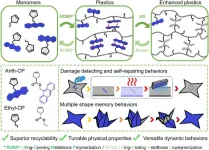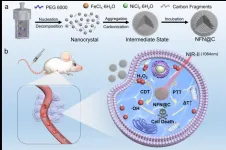(Press-News.org) Curtin University researchers have discovered the world’s oldest known meteorite impact crater, which could significantly redefine our understanding of the origins of life and how our planet was shaped.
The team from Curtin’s School of Earth and Planetary Sciences investigated rock layers in the North Pole Dome — an area of the Pilbara region of Western Australia — and found evidence of a major meteorite impact 3.5 billion years ago.
Study co-lead Professor Tim Johnson, from Curtin University, said the discovery significantly challenged previous assumptions about our planet’s ancient history.
“Before our discovery, the oldest impact crater was 2.2 billion years old, so this is by far the oldest known crater ever found on Earth,” Professor Johnson said.
Researchers discovered the crater thanks to ‘shatter cones’, distinctive rock formations only formed under the intense pressure of a meteorite strike.
The shatter cones at the site, about 40 kilometres west of Marble Bar in WA’s Pilbara region, were formed when a meteorite slammed into the area at more than 36,000km/h.
This would have been a major planetary event, resulting in a crater more than 100km wide that would have sent debris flying across the globe.
“We know large impacts were common in the early solar system from looking at the Moon,” Professor Johnson said.
“Until now, the absence of any truly ancient craters means they are largely ignored by geologists.
“This study provides a crucial piece of the puzzle of Earth's impact history and suggests there may be many other ancient craters that could be discovered over time.”
Co-lead author Professor Chris Kirkland, also from Curtin’s School of Earth and Planetary Sciences, said the discovery shed new light on how meteorites shaped Earth’s early environment.
“Uncovering this impact and finding more from the same time period could explain a lot about how life may have got started, as impact craters created environments friendly to microbial life such as hot water pools,” Professor Kirkland said.
“It also radically refines our understanding of crust formation: the tremendous amount of energy from this impact could have played a role in shaping early Earth’s crust by pushing one part of the Earth's crust under another, or by forcing magma to rise from deep within the Earth's mantle toward the surface.
“It may have even contributed to the formation of cratons, which are large, stable landmasses that became the foundation of continents.”
‘A Paleoarchean impact crater in the Pilbara Craton, Western Australia’ was published in Nature Communications.
END
World’s oldest impact crater found, rewriting Earth’s ancient history
Curtin University researchers have discovered the world’s oldest known meteorite impact crater, which could significantly redefine our understanding of the origins of life and how our planet was shaped.
2025-03-06
ELSE PRESS RELEASES FROM THIS DATE:
Pledge to phase out toxic lead ammunition in UK hunting by 2025 has failed
2025-03-06
A voluntary pledge made by UK shooting organisations in 2020 to replace lead shot with non-toxic alternatives by 2025 has failed, analysis by Cambridge researchers finds.
The pledge, made in February 2020 by the UK’s nine leading game shooting and rural organisations, aimed to benefit wildlife and the environment and ensure a market for the healthiest game meat food products.
But a Cambridge team, working with the University of the Highlands and Islands, has consistently shown that lead shot was not being phased out quickly enough to achieve ...
Possible foundations of human intelligence observed for the first time
2025-03-06
A study led by Dr. Rodrigo Quian Quiroga, group leader of the Neural Mechanisms of Perception and Memory Research Group at the Hospital del Mar Research Institute, has allowed scientists to observe for the first time how neurons in the human brain store memories independent of context in which they are acquired. Published in Cell Reports, the study confirms that neurons can distinguish objects or people regardless of their context, enabling the formation of higher and more abstract relationships, ...
Breast cancer death rates have stopped going down
2025-03-06
A new paper in the Journal of Breast Imaging, published by Oxford University Press, indicates that breast cancer mortality rates have stopped declining in women older than age 74, and reconfirms that breast cancer mortality rates have stopped falling in women younger than age 40. This finding for older women is new.
Breast cancer is the second leading cause of cancer deaths in American women, with over 42,000 women dying of the disease in 2024. Before 1990, female breast cancer rates had been rising, and breast cancer mortality rates had been flat or increasing. Since 1990 there has been a steady decline ...
Developing zero-waste, sustainable smart polymer materials
2025-03-06
Plastics, which are polymeric materials composed of long chains of small molecules called monomers, are widely used in everyday life and industry due to their lightweight, good strength and flexibility. However, with approximately 52 million tons of plastic waste generated annually, plastic pollution has become a major environmental concern. To address this issue, research efforts have focused on developing sustainable polymeric materials. Unfortunately, most materials developed so far suffer from complex synthesis processes or difficulties in separating them from other polymers during waste disposal.
To overcome these limitations, a research team led by Dr. Tae Ann Kim of the Convergence ...
AI has ‘great potential’ for detecting wildfires, new study of the Amazon rainforest suggests
2025-03-06
A type of Artificial Intelligence that mimics the functioning of the human brain could represent a powerful solution in automatically detecting wildfires, plummeting the time needed to mitigate their devastating effects, a new study finds.
The new technology uses an ‘Artificial Neural Networks’ model that combines satellite imaging technology with deep learning (a subset of Artificial Intelligence (AI) and machine learning).
Findings, published in the peer-reviewed International Journal of Remote Sensing, report a 93% success rate when training the model via a dataset ...
Magnetic catalysts enhance tumor treatment via electronic density regulation
2025-03-06
Recently, a collaborative research team led by Professor WANG Hui and Professor ZHANG Xin from the Hefei Institutes of Physical Science of the Chinese Academy of Sciences, successfully developed a novel carbon-coated nickel ferrite (NFN@C) nanocatalyst with significant potential in cancer therapy.
The results have been published in Advanced Functional Materials.
Cancer therapy has always struggled with targeting tumor cells effectively while minimizing damage to healthy tissue. Traditional treatments like chemotherapy and radiation often have limited precision and serious side effects. This has led to increased ...
Quantum dot discovery for LEDs brings brighter, more eco-friendly displays
2025-03-06
New research by Curtin University has achieved a breakthrough in eco-friendly display technology, creating highly efficient and stable blue quantum dot LEDs (QLEDs) that could power the next generation of televisions, smartphones, VR headsets and energy-efficient lighting - without using toxic heavy metals.
Study author Associate Professor Guohua Jia from Curtin’s School of Molecular and Life Sciences said QLEDs are a futuristic display technology known for their superior brightness, colour accuracy, lifetime and energy efficiency compared to traditional LEDs. However, creating stable and efficient blue QLEDs without toxic materials ...
Phosphorus doping stabilizes high-energy polymeric nitrogen at ambient pressure
2025-03-06
Using first-principles calculations, a research group led by Prof. WANG Xianlong from the Hefei Institutes of Physical Science of the Chinese Academy of Sciences, found that phosphorus doping is an effective way to achieve high-energy polymeric nitrogen with black-phosphorus structure (BP-N) stable at ambient pressure.
The research results were published in Matter and Radiation at Extremes.
Cubic gauche nitrogen with diamond-like structure and BP-N with black phosphorus structure, represented by polymeric all-nitrogen materials, are a class of high-energy density materials composed entirely of N-N single bonds, but their samples ...
Maternal cannabis use triples risk of disruptive behaviour in children
2025-03-06
Children exposed to their mother’s cannabis use during pregnancy and after birth are three times more likely to develop behavioural problems, new Curtin University research has found.
Published in Psychiatry Research, the study analysed data from more than 222,600 Australian mothers and children, revealing maternal cannabis use disorder (CUD) during pregnancy and the postnatal period significantly increased the risk of childhood disruptive behavioural disorders.
Lead researcher Abay Tadesse, from Curtin’s School of Population ...
Balancing Nutrition: Micronutrient study could help prevent childhood obesity in Pacific region
2025-03-06
Children ages two to eight years across 11 Pacific jurisdictions (Alaska, American Samoa, Commonwealth of the Northern Mariana Islands, Federated States of Micronesia, Guam, Hawai‘i, Marshall Islands, and Palau) are not meeting daily recommended intakes for key micronutrients, either consuming too much or too little. That discovery was published recently in a study led by scientists at the University of Hawai‘i (UH) at Mānoa. The research team also found associations between children’s micronutrient intake, obesity, and presence of acanthosis nigricans, a skin condition that is ...
LAST 30 PRESS RELEASES:
Fame itself may be critical factor in shortening singers’ lives
Daily coffee drinking may slow biological ageing of people with major mental illness
New highly efficient material turns motion into power – without toxic lead
The DEVILS in the details: New research reveals how the cosmic landscape impacts the galaxy lifecycle
After nearly 100 years, scientists may have detected dark matter
Gender imbalance hinders equitable environmental governance, say UN scientists
Six University of Tennessee faculty among world’s most highly cited researchers
A type of immune cell could hold a key to preventing scar tissue buildup in wounds
Mountains as water towers: New research highlights warming differences between high and low elevations
University of Tennessee secures $1 million NSF grant to build semiconductor workforce pipeline
Biochar shows powerful potential to build cleaner and more sustainable cities worldwide
UT Health San Antonio leads $4 million study on glucagon hormone’s role in diabetes, obesity
65-year-old framework challenged by modern research
AI tool helps visually impaired users ‘feel’ where objects are in real time
Collaborating minds think alike, processing information in similar ways in a shared task
Routine first trimester ultrasounds lead to earlier detection of fetal anomalies
Royal recognition for university’s dementia work
It’s a bird, it’s a drone, it’s both: AI tech monitors turkey behavior
Bormioli Luigi renews LionGlass deal with Penn State after successful trial run
Are developers prepared to control super-intelligent AI?
A step toward practical photonic quantum neural networks
Study identifies target for disease hyper progression after immunotherapy in kidney cancer
Concordia researchers identify key marker linking coronary artery disease to cognitive decline
HER2-targeted therapy shows promising results in rare bile duct cancers
Metabolic roots of memory loss
Clinical outcomes and in-hospital mortality rate following heart valve replacements at a tertiary-care hospital
Too sick to socialize: How the brain and immune system promote staying in bed
Seal milk more refined than breast milk
Veterans with cardiometabolic conditions face significant risk of dying during extreme heat events
How plants search for nutrients
[Press-News.org] World’s oldest impact crater found, rewriting Earth’s ancient historyCurtin University researchers have discovered the world’s oldest known meteorite impact crater, which could significantly redefine our understanding of the origins of life and how our planet was shaped.




